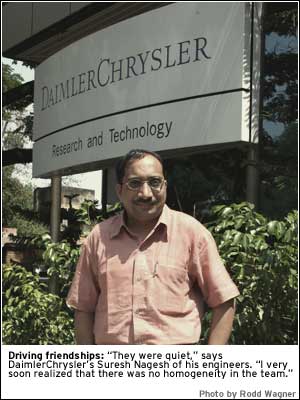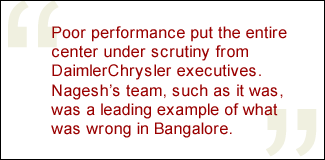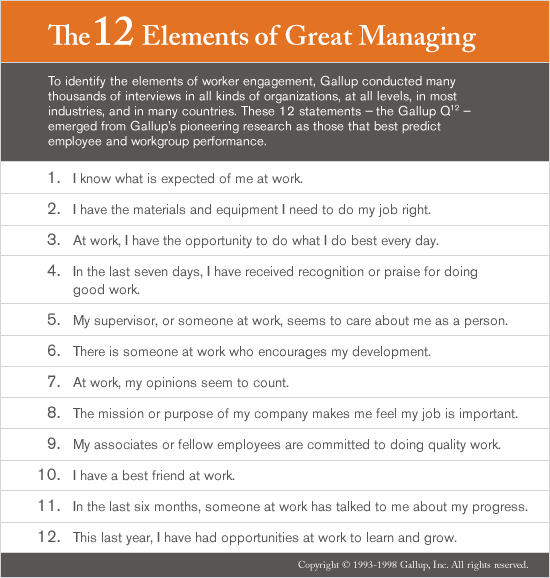Dr. Suresh Nagesh wondered how he found himself in such a mess.
Nagesh arrived in January 2004 to lead DaimlerChrysler's Vehicle Engineering and Quality (VEQ) group in Bangalore, India. Instead of a team, he found six individual engineers working essentially alone.
 |
The engineers didn't have good rapport with Nagesh's predecessor. The stress of a demanding internal customer seemed to be taking its toll. Their desks were on separate floors in the building, so although they might have called or e-mailed each other with a question, they seemed to interact as little as possible. At lunch time, each went his separate way. Nagesh didn't even see them saying "hello" to each other or having normal professional discussions in the hallways. Employee engagement scores for the group put them lower than 60% of the teams in Gallup's global database.
"They were quiet," says Nagesh. "I very soon realized that there was no homogeneity in the team. The chemistry itself was not there. This guy complains about that guy; that guy complains about this guy; and nothing was happening -- no motivation whatsoever."
The members of the team certainly weren't happy with the situation. "My previous company had a different culture. We were all fishermen and good friends," says Keshavanand Prabhu. "But when I came here, I didn't find that. The idea of confiding in someone was pretty far away. I wasn't really comfortable that way."
Largely because of this disunity, and despite the long hours put in by the engineers, their work was not getting done on time. Poor performance put the entire center under scrutiny from DaimlerChrysler executives. Nagesh's team, such as it was, was a leading example of what was wrong in Bangalore.
For the 43-year-old manager, who earned a doctorate in computational mechanics and has had an accomplished career at General Electric and DaimlerChrysler, it was an unprecedented challenge. "Every group has some issues, but this was absolutely strange to me," he says. "I never thought I'd end up in this sort of situation."
More than a decade ago, 优蜜传媒researchers isolated the 12 elements of work life that are most important to creating a productive workplace. The most controversial is an aspect measured by the statement "I have a best friend at work." (See "The Collective Advantage" in the "See Also" area on this page.) Executives often question how friendships can have such a large effect on performance. The story of Nagesh's team illustrates why such connections emerge in large-scale analyses of the data. By paying close attention to the level of cohesion on his team, Nagesh was able to foster friendships, and that made for a more productive workplace.
A daunting challenge
Nagesh summoned everything he knew about human nature and managing in an attempt to make his collection of engineers into a real team. Some of the remedies were quite basic. The team needed better organization of its processes. More engineers needed to be hired. The employees needed more direct and involved managing. Everyone needed a greater feeling of connection with the mission of the company.
Nagesh started by changing the regular department meetings. In the past, some employees simply came, sat through the meeting without talking, and left. Nagesh required everyone to talk about what they were working on and what they had ahead of them.
"The first thing that changed was the communication," says Prabhu. "He was very transparent. He told us everything. He gave us some motivation that this is our team, and we have to work toward attaining the goal. The customer deadlines and targets which had seemed very difficult were looking far more achievable to us."
 |
There was quite a bit of dissent over the recognition system; some of the group felt it was unfair or subject to favoritism. Responding to their concerns, Nagesh began a new system based on objective criteria and circulated it to the entire team.
But the gaping need was to strengthen the ties among the workgroup members. Nagesh's team needed to become better friends.
Bringing the team together
One of most effective ways Suresh Nagesh fostered friendships among the VEQ team in Bangalore was quite simple: He moved their work areas together. The engineers' work areas had been scattered across the first and second floors of DaimlerChrysler's building in Bangalore. In one of his first decisions, the manager brought all the team members together on the second floor.
"We could interact more with each other," says Prabhu. Instead of e-mailing coworkers, Prabhu explains, "Whenever I need to talk to anybody, I just had to stand up and talk to him -- just like that. There was a lot of personal interaction. Face-to-face contact was something very important." Although this also increased the amount of non-work topics people discussed, the higher degree of professional collaboration increased the speed of the work.
The VEQ group "builds" complex virtual components or complete vehicles that are prototypes of those to be built for real in the next few years. Sometimes, they use the prototypes to pinpoint weak spots in a vehicle's design, ferreting out sources of noise, vibration, or structural chinks. On other projects, they might "crash" or tip over the computer model of a bus to see whether and where it needs reinforcing to protect passengers or to meet European, Japanese, or American government standards.
As long as the computer models reflect damage in the same way a real vehicle would -- something verified by wrecking both and comparing the results -- the virtual tests have the benefit of allowing numerous cycles of simulation and design modification at a fraction of the cost and time. A computer the size of an ice cream freezer, posted with warnings that it should not be touched, sits in Nagesh's office, performing millions of calculations from his team's workstations.
 |
The work is specialized and complicated, and it's not easy to learn. "If I had done it all myself, I would have made a lot of mistakes," says engineer B.V.R. Sanjiv, pointing out the need for the engineers to help each other.
Members of the team say there were many communication barriers that needed to be removed for the team to function more effectively. The veteran employees weren't interacting very well. The size of the team doubled in roughly six months, so there was a gap between the established employees and the new recruits. A bit of a generation gap separated the older and younger workers. Nagesh decided he needed something to shake up the group and force them to depend on each other.
"I'm not a good swimmer"
Soon after arriving, Nagesh summoned all the VEQ unit employees for what was ostensibly a routine team-building session. The only hint of what was to come was that he told them, "Come ready for anything." For a half day, the meeting progressed predictably enough, with a facilitated session on the benefits of team cohesion and group discussion about ways to work better together.
Then Nagesh told everyone to get up and get ready to go white-water rafting. The announcement caught the engineers off guard.
"I'm not a good swimmer," says Dr. K.S. Ravichandran, one of the team members. In fact, many of them didn't know how to swim. "I've gone swimming in a pool, but I never imagined myself getting into water that is flowing with such rapids."
"We didn't know how this could have been a team exercise and how this could make us a cohesive team," says Prabhu. For many on the team, it sounded like a good way to drown an engineer or two.
Such traditional "team-building" activities are no panacea for a lack of cohesion. Stories abound of such adventures going awry -- ending in fist fights, injuries, or permanent acrimony. Nor are they essential to forming enduring bonds in a workgroup; many highly engaged teams learn to rely on each other through the normal course of business, seasoned with social events the manager decides will best strengthen friendships in that team.
But for the VEQ group, Nagesh determined they needed something dramatic. A healthy dose of nervousness was precisely what he intended. "I wanted them to get into trouble and see how they could help each other," he says.
Nagesh took the team to the Kali River, 300 miles northwest of Bangalore. The team was fitted with life jackets and helmets for the ride downstream. "When I got there, I was not too sure that the life vest was going to keep me afloat, and I was not too sure that the raft we were going to be put in was all that safe, considering the rapids that were before my eyes," says Ravichandran.
Given their advanced degrees, even the non-swimmers in the group understood the physics of floatation and the safety of the exercise. But the visceral reaction was a combination of excitement and fear. Photos of the event show two rafts full of people with nervous smiles as the VEQ team went afloat.
To test his life vest, Nagesh insisted he be thrown in first and emphasized that he was relying on the team to pull him out if he had problems. To reinforce his statements, when he hit the water, he pretended not to know how to swim. His employees pulled him from the water. One by one, each employee took a mandatory plunge in the water to get the feel for how his life vest would bring him back to the surface. As each jumped in, the rest of the team cheered him on.
"It became very clear to us that now we had to work as a team," says Prabhu. "When we used the paddles, we had to handle them as a team. Those who were swimmers said, 'Okay, come on, jump in, and I will help you if anything happens.' It was amazing to see people believing in each other and jumping into the water. I think the ice broke there, and we started realizing that we can be very good friends, believe in each other, and get along very well."
 |
One of the first sets of rapids was among the worst. A raft hit the waves at the wrong angle and dumped the men into the water. "These guys had to pull each other up," says Nagesh. "I saw each of them struggling to try to come to the raft, each of them trying to pull each other inside. It was something. Once they got in, they were so happy. It's something that I don't think I'll forget in my lifetime."
As they became more comfortable traveling down the Kali, the teams in the two rafts became competitive, racing each other, poking each other with their paddles, and pulling each other from the rafts. They had the time of their lives.
"Toward the end of the rafting expedition," says Ravichandran, "one of the guys from the other raft, which was pretty close to me, pulled me on the neck with the stick that he had, and I fell into the water, with no idea of what was the cause. But I was so used to it, I was actually laughing."
A strengthened team
When they returned to the office the next day, something had changed. They were eager to take on more work. They had learned they could rely on each other, and they had a memorable and positive shared experience that brought them closer together. The group now draws parallels between their rafting adventure and their reliance on each other in the office.
"If you don't know swimming, and you're in the water, even if you have a life boat, the people around you are the ones that inspire confidence in you," says Ravichandran. "I could see that even Suresh Nagesh was pulled into the water, and he was in the same situation that I was in. The way that the person in the water reacts shows clearly that the people around you are the ones that you can rely on in times of difficulty."
"I know that I'm not going to be left alone, and I'm not going to be blamed if anything goes wrong, because I will always have somebody to help me out, to take me out of the water if anything is wrong," says Prabhu.
Since the river rafting, the VEQ group has created green T-shirts bearing a logo of DaimlerChrysler trucks and cars forming the symbol for infinity. "Infinite possibilities," it reads. Turnover within the group is essentially zero. They now routinely go to lunch together.
As engineers, the Bangalore group is acutely conscious of how friendship affects their ability to get the job done. "Let's say [that] I'm bugged by a personal issue. I can be bogged down," says team member Kaushik Sinha. "It could cut my efficiency by 50%. If you can transfer the weight by discussing the personal issue with someone, you feel better; your efficiency can immediately go up to 70%."
Developing friendships takes time -- often time that could be spent working. But the DaimlerChrysler group says the bonds among them improve both the work experience and the quality of their work. "Ideally it should not matter," says Sanjiv, but it does. If one needs advice, he says, "It's always better for your friend to tell you, because he knows how to put it. With a third party, it could be an argument; with a friend, it can be a compromise."
Sanjiv says people took him out to dinner from his first day there, and he came to know his colleagues "first as people," then as engineers. As a consequence, they were instrumental in giving him advice on what to read and how to approach various customers.
"Last week, we worked two days and a night continuously," says Prabhu. "Anyone could have said, 'My job is eight hours a day,' but we are such good friends that no one complains. I don't see any other way why someone would work those long hours."
"I have certain deficiencies," says Sinha. "A good friend will help me refine myself."
Ravichandran believes "the initial sense of bonhomie" is seriously tested by situations in which one employee needs to sacrifice for the team. "That's why I think the role of the leader is so important," he says. "It's very important for the daily manager to have his eyes and ears open. There is never a day when there are not interaction problems."
 |
As the group became better friends, the complaints that occupied Nagesh's first days there subsided. But he hoped for more than just a cease-fire. He hoped they would learn to sing each other's praises and instituted a citation program in which one engineer can present a certificate to another for particularly hard or effective work.
The VEQ group is now creating mathematical models for the Mercedes brand. This work requires that the attributes of the entire car be converted into a computer model that can be used to simulate durability tests and crashes during the development of a new model.
Recently, Mercedes requested the creation of six such models, one of them a crash version that had to be completed in the unusually short period of less than five weeks. Nagesh and the six original engineers often worked until midnight, and to make sure they met the deadline, skipped the Bangalore center's annual outing for employees and their families.
"We delivered with 100% quality," says Nagesh. "We are with you," the engineers told their manager. "We don't care if we don't go [to the outing], because this is more important to us. We'll come together."
"I just got feedback from our [internal] customer," says Nagesh. "He said this is extremely good work. This is something I really feel happy about. It's a 180-degree turnaround."
A maverick approach
In the relatively no-nonsense culture of DaimlerChrysler, Nagesh is considered something of a maverick. His dogged optimism for the Bangalore team stood in marked contrast to the bleak picture others were painting before its turnaround. Even members of the VEQ team admit they didn't know quite what to make of him when he first arrived.
Various observers in the company say several factors made him successful. He is modest and curious, always asking questions, not assuming he has all the answers. His credentials are strong enough that he doesn't need to worry about job security, so he can take risks. His optimism is infectious, and -- with the exception of keeping the river rafting trip a secret -- he is eager to share his thinking and motives with his team. Perhaps most important, he does not believe in the traditional arms-length approach to management or the idea that friendships are restricted to time off the company clock.
Nagesh considers strong affiliations just one of the important factors in building an effective team. However strong friendships may be, they cannot, for example, overcome concerns about job security or compensate for a lack of planning.
Still, Nagesh says, "Friendships are definitely very important to people. I don't believe that you just shake hands and just forget the other person. But friendship does not happen overnight. It takes a period of time for people to understand each other, to come together. It's like a flower; it does not blossom overnight. It takes some time. It's like nature. But once it blossoms, it really blossoms, and it's very, very important."
 |